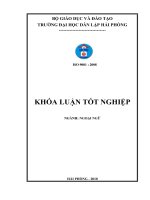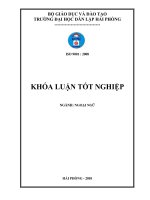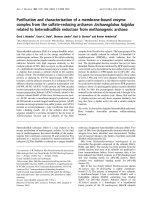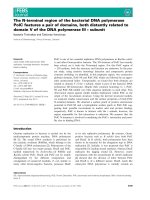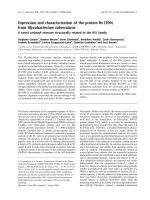assessment of cadmium flows related to domestic activities and proposal of recovery solutions
Bạn đang xem bản rút gọn của tài liệu. Xem và tải ngay bản đầy đủ của tài liệu tại đây (1.17 MB, 107 trang )
DRESDEN UNIVERSITY OF TECHNOLOGY VNU UNIVERSITY OF SCIENCE
Ngo Van Anh
ASSESSMENT OF CADMIUM FLOWS RELATED TO DOMESTIC
ACTIVITIES AND PROPOSAL OF RECOVERY SOLUTIONS
MASTER THESIS
Hanoi - 2011
DRESDEN UNIVERSITY OF TECHNOLOGY VNU UNIVERSITY OF SCIENCE
Ngo Van Anh
ASSESSMENT OF CADMIUM FLOWS RELATED TO DOMESTIC
ACTIVITIES AND PROPOSAL OF RECOVERY SOLUTIONS
Major: Waste Management and Contaminated Site Treatment
MASTER THESIS
SUPERVISOR: ASSOC. PROF. DR. NGUYEN THI HA
Hanoi - 2011
1
ABSTRACTS
This thesis analyses the flows of cadmium (Cd) concerning with domestic
activities in 3 communes (Co Loa, Tho Xuan and Duong Lieu), especially at Co
Loa using MFA (Material flow analysis) or SFA (substance flow analysis) as a
framework. MFA/SFA allows all material/substance inflows, outflows, and stocks
through each sub-compartment in 3 communes to be examined.
The results of the thesis were visualized and presented in diagrams, including
an aggregate diagram. Existing data from a large variety of sources was utilised to
complete all cadmium flows within each commune. Cadmium sources are linked to
activities of households, markets, agricultural production and on-site sanitation
system. A large content of cadmium found in daily domestic solid waste. Phosphate
fertilizers and animal manure have been identified as other significant inputs to
agricultural soils. Based on the findings, appropriate solutions for cadmium
recovery were suggested.
2
ACKNOWLEDGEMENT
My profound gratitude of course reserves for my parents and my relatives
who always create good conditions for me to pursue my education. Their
expectation and support have sustained me during the whole period of my study.
I am most indebted to my supervisor Assoc. Prof. Dr. Nguyen Thi Ha. Thank
you for your patience and for providing consistent direction, encouragement, and
constructive guidance for my thesis.
I also would like to thank Prof. Bernd Bilitewski, Prof. Peter Werner, Assoc.
Prof. Dr. Bui Duy Cam, and Assoc. Prof. Dr. Nguyen Thi Diem Trang for their
significant role in organization and support this course.
Finally, I would like to express my sincere gratitude to my friends who spent
their time helping me do my thesis.
3
TABLE OF CONTENT
ABSTRACTS 1
ACKNOWLEDGEMENT 2
TABLE OF CONTENT 3
LIST OF TABLES 5
LIST OF FIGURES 7
ABBREVIATIONS 8
INTRODUCTION 9
CHAPTER 1 – LITERATURE REVIEW 11
1.1. Overview of cadmium usage and environmental concerns 11
1.1.1. Sources and emissions 11
1.1.2. Fate, transport and transformation of cadmium in environment 16
1.1.3. Effect of cadmium on human health and environment 18
1.2. Overview of MFA 21
1.2.1. Terminology used in MFA 22
1.2.2. MFA procedure 24
1.2.3. Application of MFA 25
1.2.4. Some MFA case studies 27
CHAPTER 2 – APPROACH AND METHODOLOGY 38
2.1. Description of study area and scope 38
2.1.1. Co Loa commune 38
2.1.2. Tho Xuan commune 40
2.1.3. Duong Lieu commune 41
2.2. Methodology 42
2.2.1. System analysis 43
2.2.2. Data collection 43
4
2.2.3. Modelling approach 44
CHAPTER 3 - RESULTS 46
3.1. Result of cadmium flows identification (qualitative analysis) 46
3.1.1. Co Loa commune 46
3.1.2. Tho Xuan commune 49
3.1.3. Duong Lieu commune 53
3.2. Result of Cd flows calculation (quantitative analysis) 57
3.2.1. Cd flows calculation concerning with the activities in households 57
3.2.2. Cd flows calculation concerning with the activities in markets 61
3.2.3. Cd flows calculation concerning with industry 64
3.2.4. Cd flows calculation concerning with farmland 65
3.2.5. Cd flows calculation concerning with livestock 68
3.2.6. Cd flows calculation concerning with aquaculture 70
3.2.7. Cd flows calculation concerning with S&D 72
3.2.8. Cd flows calculation concerning with on-site sanitation 75
3.2.9. Cd flows calculation concerning with biogas 79
3.2.10. Cd flows calculation concerning with intermediate waste storage 80
3.2.11. Quantitative diagram 81
3.3. Proposal of Cd recovery solutions 82
3.3.1. Solutions to recover Cd in solid waste 82
3.3.2. Solutions to recover Cd in liquid waste 85
CONCLUSIONS 88
REFERENCES 90
ANNEXES 95
5
LIST OF TABLES
Table 1. Range in BRCs of Cd for fine-grained marine sediments, seawater and blue
mussel within the OSPAR area 12
Table 2. Cadmium and its compounds emissions to air, land and water 15
Table 3. Main physico-chemical properties and registration numbers of Cd 16
Table 4. Cadmium intake for members of the public (1994) 19
Table 5. Amount of phosphate ore was mined in some countries during 2005 32
Table 6. Cultivation productivity in Co Loa in 2009 39
Table 7. Breeding productivity in Co Loa in 2009 39
Table 8. Cadmium flows from domestic activities in Co Loa commune 46
Table 9. Cadmium flows from domestic activities in Tho Xuan commune 50
Table 10. Cadmium flows from domestic activities in Duong Lieu commune 54
Table 11. Variables in HH activity 57
Table 12. Values for calculation of Cd flows in HH activity 59
Table 13. Summary for Cd flows calculation concerning with activities in HH 61
Table 14. Variables in markets activity 62
Table 15. Values for calculation of Cd in markets activity 62
Table 16. Summary for Cd flows calculation concerning with activities in markets 63
Table 17. Variables in industry activity 64
Table 18. Values for calculation of Cd flows in industry activity 64
Table 19. Summary for Cd flows calculation concerning with industry 65
Table 20. Variables in farmland activity 66
Table 21. Values for calculation of Cd flows in farmland activity 66
6
Table 22. Summary for Cd flows calculation concerning with farmland 67
Table 23. Variable in livestock activity 68
Table 24. Values for calculation of Cd flows in livestock activity 69
Table 25. Summary for Cd flows calculation concerning with livestock 70
Table 26. Variables in aquaculture activity 71
Table 27. Values for calculation of Cd flows in aquaculture activity 71
Table 28. Summary for Cd flows calculation concerning with aquaculture 71
Table 29. Variables in S&D activity 72
Table 30. Values for calculation of Cd flows in S&D 73
Table 31. Summary for Cd flows calculation concerning with S&D 75
Table 32. Variables in septic tank system 76
Table 33. Values for calculation of Cd flows in septic tank system 76
Table 34. Variables in double vaults toilet system 77
Table 35. Values for calculation of Cd flows in double vaults toilet system 77
Table 36. Variables in on-site sanitation activity 78
Table 37. Summary for Cd flows calculation concerning with on-site sanitation 78
Table 38. Variables in biogas activity 79
Table 39. Values for calculation of Cd flows in biogas activity 79
Table 40. Summary for Cd flows calculation concerning with biogas 80
Table 41. Variables in intermediate waste storage activity 80
Table 42. Values for calculation of Cd flows in intermediate waste storage activity 80
Table 43. Summary for Cd flows calculation concerning with intermediate waste
storage 81
7
LIST OF FIGURES
Fig. 1. Graphical representation of an MFA system 24
Fig. 2. MFA procedure 25
Fig. 3. Co Loa commune 38
Fig. 4. Tho Xuan commune 40
Fig. 5. Duong Lieu commune 41
Fig. 6. Protocol for substance flow analysis 42
Fig. 7. System analysis of domestic activities in Co Loa 49
Fig. 8. System analysis of domestic activities in Tho Xuan 53
Fig. 9. System analysis of domestic activities in Duong Lieu 56
Fig. 10. Input and output flows concerning with household activity 57
Fig. 11. Input and output flows concerning with markets activity 61
Fig. 12. Input and output flows concerning with industry activity 64
Fig. 13. Input and output flows concerning with farmland activity 65
Fig. 14. Input and output flows concerning with livestock activity 68
Fig. 15. Input and output flows concerning with aquaculture activity 70
Fig. 16. Input and output flows concerning with S&D activity 72
Fig. 17. Input and output flows concerning with on-site sanitation activity 75
Fig. 18. Input and output flows concerning with septic tank system 76
Fig. 19. Input and output flows concerning with double vaults toilet system 77
Fig. 20. Input and output flows concerning with biogas activity. 79
Fig. 21. Input and output flows concerning with intermediate waste storage activity80
Fig. 22. Quantitative diagram for Cd flows in Co Loa commune 82
8
ABBREVIATIONS
ELM Emulsion liquid membranes
EW Electro winning
FAO Food and Agriculture Organization
GESAMP Joint Group of Experts on the Scientific Aspects of
marine Pollution
GW Groundwater
HH Households
IARC International Agency for Research on Cancer
kt Kilotons
MFA Material flow analysis
OECD Organization for Economic Co-operation and
Development
PVC
Polyvinyl chloride
SFA Substance flow analysis
S&D Sewer and drainage system
SX Solvent extraction
The OSPAR Convention The Convention for the Protection of the Marine
Environment of the North-East Atlantic
US EPA United State Environmental Protection Agency
WC Water closet
WHO World Health Organization
9
INTRODUCTION
Cadmium is usually found in trace amounts as a component of the surface
soil, sediments and surface water, and in the air. However, most of the cadmium in
the environment results directly from human activities. Cadmium is not essential to
living organisms. It enters the human body via food, smoking, and inhalation of
contaminated air. It is extremely dangerous as it is easily absorbed and remains in
the tissues for a long time. Because of the slow rate of cadmium excretion, levels in
the body increase with age in situations of chronic exposure. Human kidney disease
(renal dysfunction) is one result of such long-term exposure (WHO 1992).
Assessment of cadmium flows by material flow analysis method originally
developed by Baccini and Brunner, 1991; can provide a holistic picture of resource
use and loss in a geographic region in a specific year. In industrialized countries,
MFA proved to be a suitable instrument for the early recognition of environmental
problems and development of countermeasure. It can be applied to analyze resource
flows in a city, particularly to evaluate the impact of changes in consumption
patterns, solid waste and wastewater treatment infrastructure, peri-urban agricultural
production, including waste and wastewater reuse practices on resource
consumption and environmental pollution. It also provides useful information for
planners and decision-makers and could help improve resource management of
areas in developing countries. However, limited data availability, reliability and
data collection means (available laboratory equipment, trained laboratory staff,
financial and human resources) are common problems faced by developing
countries and restrain the use of MFA as a policy-making tool.
The aim of this study is to apply MFA to analyze the cadmium flows through
domestic activities to the environment. The study areas are 3 communes (Co Loa –
peri-urban area, Tho Xuan – rural area and Duong Lieu - craft village area. Contents
of thesis include:
10
9 Description and understanding the activities related to cadmium flows
9 Qualification and quantification these flows
9 Recommendation of appropriate solutions for cadmium recovery
11
CHAPTER 1 – LITERATURE REVIEW
1.1. Overview of cadmium usage and environmental concerns
1.1.1. Sources and emissions
Cadmium is released to the biosphere from both natural and anthropogenic
sources.
1.1.1.1. Natural sources
Many substances, such as cadmium, occur naturally in the environment and
it is therefore important to distinguish between natural concentrations and flows of
these substances and the extent to which these are increased by human activities.
Volcanic activity is an important natural source of the release of cadmium to
the atmosphere. The annual global flux from this source has been estimated to be
820 tons (Nriagu, 1989). Deep-sea volcanism is also a source of the release of
cadmium to the environment, but the role of this process in the global cadmium
cycle still remains to be quantified. Levels of up to 4.5 mg/kg have been found in
volcanic soils (Korte, 1983).
Cadmium present in various types of rocks and soils is widely distributed in
the earth's crust, in non-volcanic areas, at average concentrations ranging from 0.1
to 0.2 mg/kg of soil (GESAMP, 1984). This metal is commonly associated to zinc,
and occurs naturally in zinc, lead and copper ores, which are the main deposits of
cadmium. These deposits can reach ground and surface waters, especially when in
contact with soft, acidic waters.
For naturally occurring substances the Background/Reference
Concentrations (BRCs) are the range of concentrations that would be anticipated to
be present in the environment in the absence of any human activity. Obviously,
nowadays it is virtually impossible to present a definitive value for the background
concentration of natural stable compounds, which can be transported by wind, water
and biota.
12
Table 1 summarizes available BRCs for cadmium in seawater, sediments and
biota (mussel tissue)
a
: from OSPAR Commission, 2002
1.1.1.2. Anthropogenic sources
There are a number of sources of anthropogenic cadmium emissions into the
environment. Many of these are emitted as a result of activities not (directly)
associated with the production and use of cadmium-containing products. These
include (Nordic Council of Ministers, 2003):
• Refining of non-ferrous metals - residual levels of cadmium in zinc and lead
ores; copper refining with the level of emissions is low.
• Production of iron and steel - emissions to air, water and landfill may result
from several of the input materials and processes for converting iron ore,
Table 1. Range in BRCs of Cd for fine-grained marine sediments, seawater
and blue mussel within the OSPAR area
(
2002
)
a
13
coke and limestone/fluorspar to iron; production of refined steel from pig
steel; or for secondary production of steel from scrap steel.
• Combustion of fossil fuels - cadmium is a natural component of fossil fuels.
Electric power plants burning fossil fuels (coal and/or oil) release cadmium
contained in the fuels which contain zinc sulphides. As much as 190 ppm of
cadmium occurs in mid-continental coals in the US. Most cadmium will be
captured in the fly ash and emission control devices; a small volume may be
present in the slag/bottom ash which is landfilled or immobilized in cement
or asphalt-type processes.
• Production/use of phosphate fertilizer - cadmium is contained in the
phosphate fertilizers from the original rock phosphate. Emissions may also
occur through losses to water during the manufacturing process and disposal
of by-product gypsum to sea and disposal of gypsum to landfill. Minor
emissions may take place to air through dust created during manufacture.
• Production of cement - cadmium is present as trace element in the raw
materials of cement production. Emissions may result from the feed system,
kiln system, clinker-cooling and handling system. Emissions to air as dust
are likely, while direct emissions to water are not.
Cadmium also enters the environment through the disposal of solid and
liquid wastes, some of which will be associated with the production and use of
cadmium-containing products (United Nations Environment Programme, 2008)
• Application of sewage sludge - to soil through application to land as fertilizer.
• Incineration of domestic waste - cadmium is also released as a result of
incinerating cadmium stabilized PVC and other products containing
cadmium pigments or cadmium compounds found in commercial and
household waste.
14
• Leaching from landfill - cadmium concentration in leachates from controlled,
state-of-the-art industrial or municipal landfills is often below the detection
limit. By way of example, in a case study in Denmark on a landfill
containing industrial/municipal waste, demolition waste, 3% hazardous
waste – no elevated cadmium was observed and the concentration was below
detection.
Table 2 shows the most significant sources of cadmium emissions in some
European countries, taking into account overall use of cadmium
15
a
: from Urszula Zielonka et al., 2009
Table 2. Cadmium and its com
p
ounds emissions to air, land, and water
(
2009
)
a
16
1.1.2. Fate, transport and transformation of cadmium in environment
1.1.2.1. Fate of cadmium in environment
Cadmium is a natural element in the earth's crust. Pure cadmium is a soft,
silver-white metal; however cadmium is not often found in the environment as a
metal. It is usually found as a mineral combined with other elements such as oxygen
(cadmium oxide), chlorine (cadmium chloride), or sulfur (cadmium sulfate,
cadmium sulfide). These compounds are solids that may dissolve in water but do
not evaporate or disappear from the environment. Physico-chemical properties and
classification numbers of cadmium compounds were summarized in the WS Atkins
Report (see table 3).
a
: from Caspar Corden et al., 2000
Table 3. Main
p
h
y
sico-chemical
p
ro
p
erties of Cd com
p
ounds
(
2000
)
a
17
1.1.2.2 Transport and transformation of cadmium in environment
Cadmium is released by various natural and anthropogenic sources to the
atmosphere, aquatic environments (fresh and salt water environments) and
terrestrial environments. There are fluxes between these environmental components.
Cadmium released to the atmosphere can deposit to land and aquatic environments,
and some cadmium emitted to soil over time will be washed out to the aquatic
environments. The long-term sinks are deep-sea sediments and, to a certain extent,
controlled landfills, in cases where, owing to its physico-chemical properties,
cadmium is immobilized and remains undisturbed by anthropogenic or natural
activity (climatic and geological).
Cadmium, once released to air, is subject to atmospheric transport. It is
mainly emitted to the atmosphere in particle form. The atmospheric transport of
cadmium is governed by aerosol (particle) transport mechanisms: in the atmosphere,
cadmium may be transported on local, national, regional or intercontinental scales,
depending on various factors, including, for both natural and anthropogenic sources,
particle size, the height of emission outlets and meteorology. Because it has a
relatively short residence time in the atmosphere (days or weeks), however, this
metal is mainly transported over local, national or regional distances.
Based on the relatively scarce specific evidence available, cadmium is
considered to be subject to a certain degree of long-range air transport on an
intercontinental scale. Intercontinental transport is, however, expected to make only
a minor contribution to cadmium levels in regions affected by other, local emitting
sources. The regional and intercontinental atmospheric transport of cadmium
contributes to deposition in remote regions, such as the Arctic, where there are few
local sources for cadmium releases.
There is no hemispheric transport modeling for cadmium. As cadmium
transport is governed by aerosol transport mechanisms similar to those governing
the transport of lead (both are transported on aerosol particles with similar
18
properties), the transport of lead might be used as a rough surrogate of the potential
intercontinental transport of cadmium. Lead modeling is described in the United
Nations Environment Programme review of scientific information on lead. Taking
into account the general similarities between the long-range atmospheric transport
of cadmium and lead and building on observations for lead, major contributions to
Arctic cadmium pollution can be expected, as is the case with lead pollution, to
come from sources located in Europe and in Siberia.
With regard to aquatic systems, rivers transport cadmium and other heavy
metals on a national and regional scale. Ocean transport also occurs. The oceanic
residence time of cadmium has been estimated at about 15,000 years. This indicates
that cadmium may be accumulated and transported in significant amounts over long
distances in the ocean. It should be noted, however, that oceans have large natural
reservoirs of cadmium. The contribution of cadmium via rivers into the marine
environment of the North Sea is in the same order of magnitude as the atmospheric
deposition, which is the other main pathway of cadmium inputs in the region
(United Nations Environment Programme, 2008).
1.1.3. Effect of cadmium on human health and environment
1.1.3.1. Human exposure pathways and effect of cadmium on human health
• Non-Occupational Exposure
Typical figures for cadmium intake by members of the public within the
European Union are summarized in Table 4.
The cadmium intake is dominated by dietary intake and some foodstuffs are
cadmium “rich” - such as shellfish, root vegetables and cereals – leading to certain
population groups being at a higher risk. In areas of contamination, levels of
cadmium may be much higher leading to daily intakes of >100 mg (Järup et al.,
1998). Although cadmium use in stabilizers, pigments and plating will make a
contribution to these figures, other sources may be more significant (United Nations
Environment Programme, 2008).
19
a
: From OECD, 1994
Apart from the types of exposure outlined above, workers involved with the
dealing and use of cadmium may be exposed to cadmium dust and/or fume. The
primary route for human uptake is via inhalation of workplace air. For example, air
concentrations in the workplace of the order of 10-50 mg/m
3
would lead to a daily
uptake of 25-125 mg (OECD, 1994).
WS Atkins,1998a provided details on workplace exposures at stabilizer and
pigment preparation facilities, stabilizer mixing facilities and plating facilities. Of
those few facilities that provided information on air concentrations, it was found
that the levels were consistent with those given above (i.e. 10-50 mg/m
3
) - although
those in plating facilities were much lower at around 1 mg/m
3
. Overall (although no
data from plating facilities were supplied) it was found that cadmium levels in
workers’ blood were less than 5 mg/l - a value to be compared with a typical value
of 1 mg/l among the general population (levels for smokers are about twice those
for non-smokers) (Caspar Corden et al., 2000).
• Human health effects
Cadmium is a non-essential and toxic element for humans. The kidney is
considered the critical target organ for toxicity of cadmium in humans. The main
critical influences include an increased excretion of proteins in urine as a result of
proximal tubular cell damage. The severity of the effect depends on duration and
magnitude of exposure.
Table 4. Cadmium intake for members of the
p
ublic
(
1994
)
20
Skeletal damage is another critical effect of chronic cadmium exposure at
levels somewhat higher than those for which kidney proteinuria occurs. Kidney
proteinuria is an early effects indicator (United Nations Environment Programme,
2008).
The International Agency for Research on Cancer classifies cadmium in
Group 1: carcinogenic to humans and the US Environmental Protection Agency has
determined that cadmium is a probable human carcinogen by inhalation
Epidemiological data from occupational settings confirm lungs being the primary
target organ. Cadmium is not considered a carcinogen by ingestion.
Cadmium is mainly stored in the liver and kidneys. Excretion is normally
slow, and the biological half-life is very long (decades) in the muscles, kidneys,
liver, and whole body. Cadmium concentrations in most tissues increase with age
(Caspar Corden et al., 2000).
1.1.3.2. Effect of cadmium on environment
In the environment, some cadmium compounds are relatively water soluble,
mobile in soil and bioavailability, depending on the water and soil chemistries. It
tends to bioaccumulation in organs such as the kidney and liver of vertebrates, but
aquatic invertebrates and algae can also build up relatively high concentrations.
In terrestrial ecosystems, soil micro-organisms and plants are more sensitive
to cadmium than soil invertebrates. Both invertebrates and plants can accumulate
cadmium. Predators feeding on such soil invertebrates can give cadmium into the
food chain, which suggests a risk of secondary poisoning through the food chain
from worms to higher tropic levels (birds or mammals). The accumulation of
cadmium by plants results in this contaminant entering the human food chain
(United Nations Environment Programme, 2008).
Effects on birds and mammals are mainly due to kidney damage
(dysfunction), and in sea birds and marine mammals in particular, cadmium
accumulates to relatively high levels. In the terrestrial environment, vascular plants
21
and micro-organisms are more sensitive to cadmium than soil fauna. Inhibition of
nitrogen-fixation in soil occurs at moderate cadmium pollution levels.
In the aquatic environment, cadmium toxicity varies considerably even
between rather closely related species, but overall the sensitivity decreases in the
following order: invertebrates > fish and amphibians > primary producers (such as
algae). Generally, cadmium toxicity decreases with increasing water hardness.
Reproduction processes and early life stages are the most sensitive.
In aquatic systems, cadmium is most readily absorbed by organisms directly
from the water in its free ionic form Cd (II). The acute toxicity of cadmium to
aquatic organisms is related to the free ionic concentration of the metal. Cadmium
interacts with the calcium metabolism of animals. In fish it causes lack of calcium
(hypocalcaemia), probably by inhibiting calcium uptake from the water. However,
high calcium concentrations in the water protect fish from cadmium uptake by
competing at uptake sites. Effects of long-term exposure can include larval
mortality and temporary reduction in growth. Zinc increases the toxicity of
cadmium to aquatic invertebrates. Sub lethal effects have been reported on the
growth and reproduction of aquatic invertebrates; there are structural effects on
invertebrate gills (Nordic Council of Ministers, 2003).
1.2. Overview of MFA
MFA is a systematic assessment of the flows and stocks of materials within a
system defined in space and time. It connects the sources, the pathways, and the
intermediate and final sinks of a material. Because of the law of the conservation of
matter, the results of an MFA can be controlled by a simple material balance
comparing all inputs, stocks, and outputs of a process. It is this special characteristic
of MFA that makes the method useful as a decision-support tool in resource
management, waste management, and environmental management (Brunner and
Rechberger, 2004).
22
1.2.1. Terminology used in MFA
1.2.1.1. Substance
In chemistry, a substance is defined as a single type of matter consisting of
uniform units. If the units are atoms, the substance is called an element, such as
carbon (C), nitrogen (N), cadmium (Cd); if they are molecules, it is called a
chemical compound, such as carbon dioxide or (CO
2
), ammonium (NH
3
) or
cadmium chloride (CdCl
2
) (Agnès Montangero et al., 2005)
1.2.1.2. Goods
Goods are substances or mixtures of substances that have economic values
assigned by markets. In economic terms, the word goods are more largely defined to
include immaterial goods such as energy (e.g., electricity), services, or information.
In MFA terminology, however, the term goods stand for material goods only.
Nevertheless, the link between goods as defined by MFA and other goods as used
by economists can be important when MFA is applied, for example, for decisions
regarding resource conservation (Brunner and Rechberger, 2004).
1.2.1.3. Process
A process is determined as a transport, transformation, or storage of
materials. The transport process can be a natural process, such as the movement of
dissolved phosphorous in a river, or it can be man made, such as the flow of gas in a
pipeline or waste collection. The same applies to transformations (e.g., oxidation of
carbon to carbon dioxide by natural forest fires vs. man-made heating systems) and
storages (e.g., natural sedimentation vs. man-made landfill).
Processes are linked by flows (mass per time) or fluxes (mass per time and
cross section) of materials. Flows/fluxes across systems boundaries are called
imports or exports. Flows/fluxes of materials entering a process are named inputs,
while those exiting are called outputs (Brunner and Rechberger, 2004).
23
1.2.1.4. Stocks
Stocks are determined as mass within the analyzed system, and they have the
physical unit of kilograms. A stock is part of a process comprising the mass that is
stored within the process. Stocks are necessary characteristics of a system’s
metabolism. For steady-state conditions (input equals output), the mean residence
time of a material in the stock can be calculated by dividing the material mass in the
stock by the material flow in or out of the stock. Stocks can stay constant, or they
can increase (accumulation of materials) or decrease (depletion of materials) in size
(Brunner and Rechberger, 2004).
1.2.1.5. System and system boundaries
A system involves a set of material flows, stocks, and processes within a
defined boundary. The smallest possible system consists of just a single process.
Examples of common systems for investigations by MFA are: a region, a municipal
incinerator, a private household, a factory, a farm, etc.
The system boundary is defined in space and time. It can consist of
geographical borders (region) or virtual limits (e.g., private households, including
processes relating the private household such as transportation, waste collection,
and sewer system). When the system boundary in time is chosen, criteria such as
objectives, data availability, appropriate balancing period, residence time of
materials within stocks, and others have to be taken into account (Brunner and
Rechberger, 2004).
1.2.1.6. Graphical representation
A process is represented by a box, flows by arrows, and the system boundary
by a dashed line


